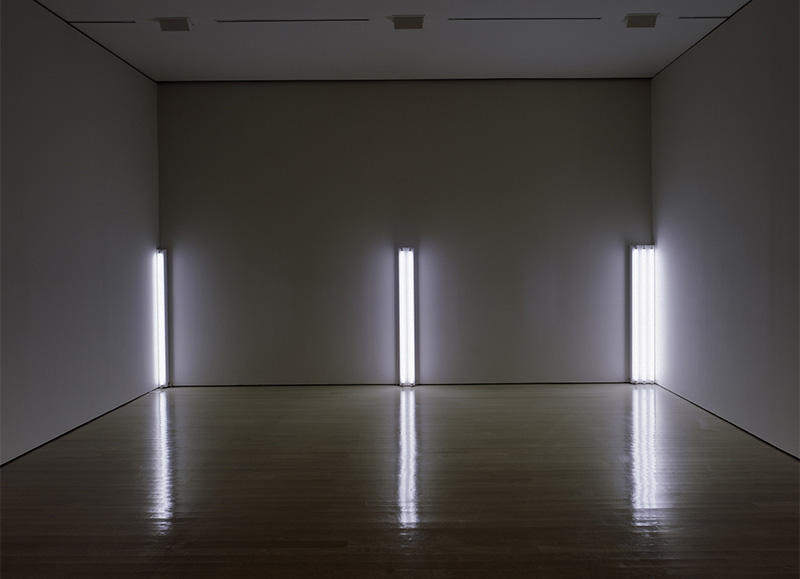ART-PREVIEW:間 Jiān

The Chinese character 間 (Jiān) is a composition of the characters for sun and door, evoking a sliver of light between two pillars. It can be translated as interval, gap, space, or pause. This image-moment taps into the phenomenological aims of Minimalism, which used simplified forms to communicate the primacy of intellect and bodily awareness over artistic content.
By Efi Michalarou
Photo: Gagosian Gallery Archive
Emerging from De Stijl, Constructivism, and Suprematism, as well as American mass production, Minimalism locates the content of an artwork in the viewer, rather than in the object. “Jiān” is a group exhibition of works by: as Dan Flavin, Donald Judd and Walter De Maria selected in response to Dan Flavin’s work “The nominal three (to William of Ockham)” (1963). From 1962 Dan Flavin’s work was based on light, using common industrial lamps. “The Nominal Three (To William of Ockham)” (1963) is a pioneering work and one of his first large pieces conceived around light from fluorescent tubes and a very fixed idea of spatial relationship. The work is dedicated to the Franciscan monk and scholastic philosopher William of Ockham, who claimed, in defiance of the predominant Catholic doctrine of Saint Thomas Aquinas, that universal ideas were abstract signs, rejecting the idea that it was possible to intellectually know that God existed. Flavin’s first ideas centered around a single fluorescent piece called “One (To William of Ockham)”, while the final triple progression of elements, alluding very clearly to Catholic mysticism, appears in the definitive work held by the Museum. “The Nominal Three (To William of Ockham)” illuminates the space by groups of fluorescent tubes that increase in number, from one to three. Thus it creates a direct reference to the philosopher’s axiom that in order to explain any phenomenon, one must opt for the lowest number of variables. Walter De Maria took his calculations to the floor (as well as the land, in his Earth Works). His sculptures use mathematic permutations to produce sublime repetitions of basic geometric components. “14-Sided Open Polygon” (1984) is a stainless steel channel containing a steel ball. Looking down upon this shiny tetradecagon, one imagines the ball rolling infinitely along the interior angles. Often, Minimalism examines the realm between painting and sculpture. Donald Judd, became dissatisfied with painting in the late ‘50s because he wished to present objects as themselves, rather than as representations on a surface. He sought to get rid of everything except for order, to reveal a self-defining structural logic in all forms. “Untitled (88-28 A/B)” (1984) is comprised of two rectangular units, aluminum boxes with blue Plexiglas panels, protruding from the wall.
Info: Gagosian Gallery, 7/F Pedder Building, 12 Pedder Street, Central, Hong Kong, Duration: 25/11/16-7/1/17, Days & Hours: Tue-Sat 11:00-19:00, www.gagosian.com
